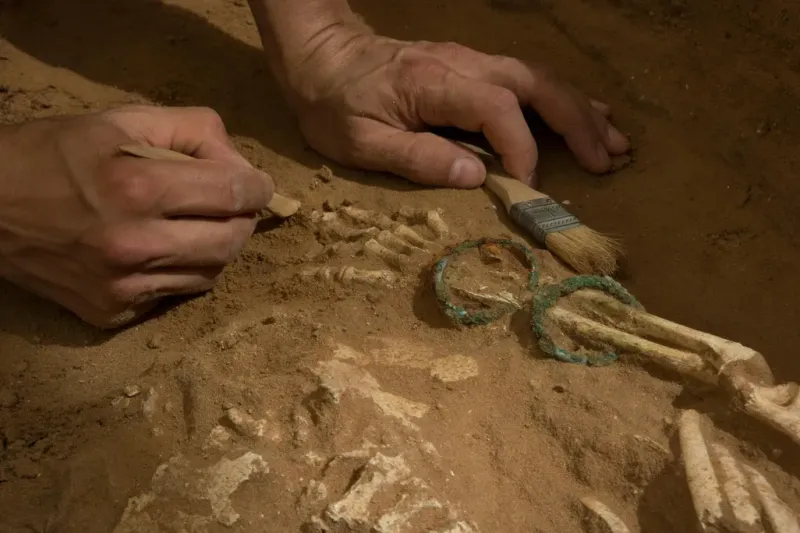The Philistines have long been known as biblical villains, frequently at war with the ancient Israelites. For centuries, their true origins remained shrouded in mystery.
Recently, scientists made an amazing breakthrough by analyzing DNA from ancient Philistine skeletons. These genetic findings have completely changed what we thought we knew about these ancient people.
1. European Roots Confirmed
The ancient Philistines weren’t native to the Holy Land after all! DNA evidence shows they migrated from southern Europe, likely the Aegean region including modern-day Greece, Crete, or Cyprus.
This discovery confirms what archaeologists had long suspected based on pottery styles and burial customs. The genetic evidence provides the smoking gun that finally proves the Philistines were newcomers to the Levant.
2. Genetic Time Capsule
Scientists hit the jackpot when they recovered viable DNA from Philistine remains. Ancient DNA typically degrades quickly in warm climates like Israel, making this discovery particularly remarkable.
The samples came from a cemetery in Ashkelon discovered in 2016. Researchers extracted genetic material from teeth and ear bones, which preserve DNA better than other skeletal elements.
3. Sea Peoples Connection
Remember those mysterious “Sea Peoples” who terrorized ancient civilizations? Genetic evidence now strongly links the Philistines to these enigmatic maritime raiders who attacked Egypt and other Mediterranean powers around 1200 BCE.
Egyptian records describe these invaders but never clarified their origins. The DNA findings support theories that at least some Sea Peoples settled permanently in the Levant, becoming what we know as Philistines.
4. Cultural Melting Pot
Far from remaining isolated foreigners, the Philistines quickly began mixing with local populations. Their European genetic signature faded within just a few generations as they intermarried with native Canaanites.
This reveals a fascinating pattern of rapid cultural assimilation. While maintaining distinctive cultural practices like pottery styles and dietary habits, their genetic makeup transformed through intermarriage with neighboring peoples.
5. Sophisticated Urbanites
Calling someone a “philistine” today implies they’re uncultured – how ironic! The real Philistines created complex urban centers with advanced architecture and sophisticated craft industries.
Their five major cities – Gaza, Ashkelon, Ashdod, Ekron, and Gath – formed a powerful confederation known as the Pentapolis. Archaeological evidence shows they were skilled metalworkers who introduced advanced iron-working technology to the region.
6. Vanishing Genetic Footprint
The European DNA signature that arrived with the Philistines didn’t last long. Within about two centuries, genetic tests show they had become virtually indistinguishable from local Canaanite populations.
This rapid genetic assimilation doesn’t mean they abandoned their cultural identity. Archaeological evidence shows they maintained distinctive Philistine practices and identity long after their genetic makeup had changed.
7. Ashkelon: Gateway Port City
The ancient port city of Ashkelon served as the Philistines’ connection to their Mediterranean homeland. This strategic location allowed them to maintain trade networks across the sea while establishing their new territory.
Archaeologists have uncovered impressive fortifications and evidence of international trade at Ashkelon. The city’s prosperity relied on maritime commerce, linking the Philistines to their European origins even as they settled into their new homeland.
8. Biblical Reputation Versus Reality
The Bible portrays Philistines as arch-enemies of the Israelites, but genetics reveals a more complex story. Rather than being fundamentally different peoples, they were recent immigrants who quickly blended with local populations.
Famous biblical conflicts, like David versus Goliath, take on new meaning with this understanding. The rivalry likely stemmed more from competition for land and resources than from deep ethnic differences.
9. Dietary Cultural Markers
You are what you eat – even 3,000 years ago! Archaeologists found that early Philistines brought distinctive European food habits with them, including consuming pork and preparing food in unique cooking vessels.
These dietary practices set them apart from neighboring Canaanites and Israelites who generally avoided pork. Food remains and cooking implements provide tangible evidence of the Philistines’ foreign origins, complementing the genetic discoveries.
10. Genetic Research Breakthrough
The Philistine DNA study represents a remarkable scientific achievement. Researchers successfully extracted and analyzed genetic material from 10 individuals spanning different time periods, allowing them to track changes over generations.
This project, published in Science Advances in 2019, required overcoming numerous challenges related to DNA preservation in hot climates. The results provide a template for future studies of ancient population movements throughout the Mediterranean region.










